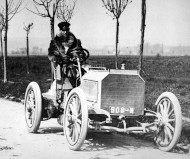12/23/2020
A History Of The First US Speed TrapsThe ideas behind Vision Zero of low speed limits and heavy enforcement are nearly 120 years old.

Speed traps and artificially low speed limits are as old as the automobile itself. At the turn of the 20th century, automobiles variously powered by electricity, steam and gasoline were available only to the wealthy. As The New York Times explained in 1902, these high-flying 'automobilists' did themselves no favors:
"When the automobile made its appearance in this country a few years ago it was received with a cordiality which was nothing short of remarkable. Whether on the city streets or the country roads, pedestrians and vehicles stopped to see it pass, and the general sentiment was obviously that of admiration.... Now the admiration and interest of at least a very large part of the public had been succeeded by open hostility."
A good deal of the resentment was based on envy. Millionaires flaunted their status by having chauffeurs drive them, in style, in imported vehicles whose prices ranged from $4000 to over $20,000 (equivalent of up to $600,000 today).
Negative feelings were compounded by certain automobile club members who would arrange impromptu races on public thoroughfares to see who could achieve the best time over a particular route. They would ignore police and anyone else who might get in their way of attaining local bragging rights. Even though the cars of the time were limited to between 12 and 40 horsepower and were extremely slow by modern standards, they were fast enough to frighten horses, which could cause serious injury or death to thrown riders. The Times continued:
"In another form this feeling against the new vehicles finds expression in the many efforts to restrict the speed of the vehicles along city streets and the suburban and country roads, and the determined nature of the opposition to the efforts of the drivers to obtain a higher speed in cities where there is an existing legal limit.... In Philadelphia sentiment has been so aroused... that an ordinance is pending in the Common Council which proposes to limit the speed of vehicles to seven miles an hour and to require operators and machines to be licensed."
Those limits of 5 to 7 miles-per-hour were imposed, forcing the automobilist to drive more slowly than even a bicyclist or speedy pedestrian. Horse-drawn carriages at the time regularly drove at 15 to 30 miles-per-hour. Drivers at the time argued the limits were absurd because motoring at 15 to 18 miles-per-hour caused no interference with local traffic.
As a result, the unrealistically low speed limits were almost universally ignored -- an easy thing to do at a time when cars had no speedometers. District attorneys in New York began to organize teams of policemen to mount a campaign to punish drivers into compliance. Teams of officers would line the side of a road, spaced an eighth or sixteenth of a mile apart from one another. The first officer would signal the next as the vehicle passed and a pocket watch was used to approximate the time elapsed between them. Another policeman on a bicycle would then engage in a "lively pursuit." An officer testified to the vehicle's speed in court with terms such as, "his machine traveled a sixteenth of a mile in ten seconds."
A police officer arresting a wealthy automobilist for exceeding a 10 MPH speed limit made front-page news. One must imagine that an ambitious district attorney would see the advantage of pandering to a public interested in slapping down the aristocracy, yet not every member of the upper class acted foolishly. Some were smart enough never to leave home without a driver.
When it became necessary to rush to catch a train or attend an event, the driver could easily outrun the police officer. By the time a policeman caught up, it was the chauffer -- not the owner -- who would be placed under arrest. In such cases, the accused would often drive the policeman straight to a judge for a quick trial. After setting bail, the judge imposed fines of up to $50 on a first offense (equivalent to $1,500 after adjusting for inflation) and six months' imprisonment for a second, with twenty-day sentences being the most common.
In another 1902 editorial, The New York Times called for speed limiters: "The next step in the direction of reform of the abuses of the automobile will be for those who honestly believe that high speeds on public roads are dangerous, to affix to their vehicles speed governors which will render it impossible to drive them beyond the legal limit. This would be the ‘swell' thing, at once removing the owner of a vehicle thus equipped from the classification of the sporty and the vulgar rich."
That year, Chicago police armed with stopwatches would hold a rope taut across the road when an allegedly speeding motorist was about to pass. "This compels the automobilist to stop or have his machine raked fore and aft by the rope." Having literally arrested the driver, police would then take him downtown.
Another early speed trap in Westchester County, New York in 1903 used a trio of police officers hiding in fake trees spaced one mile from each other. Inside, the officers held a stopwatch and a telephone. As a car passed, the first officer would record the time and phone the next tree. If the resulting calculation meant the vehicle was speeding between tree one and tree two, the third officer would drop a pole across the road to stop the car. The first trap stopped about one in twenty passing cars. Revenue was not yet the primary motive, as the drivers received warnings. The leniency did not last long as the prospect of using tickets to generate revenue began to take hold.


